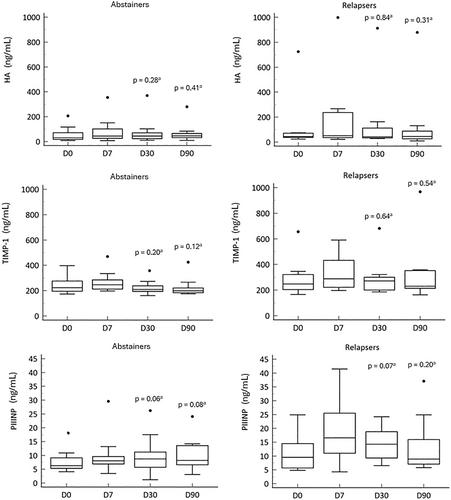Enhanced liver fibrosis score is stable after withdrawal in patients with heavy alcohol consumption: A pilot study
Abstract
Background
Enhanced liver fibrosis (ELF) score is an accurate, noninvasive test for assessing the severity of liver fibrosis in chronic liver disease, including alcohol-related liver disease. However, whether the ELF score changes during alcohol withdrawal is unknown. This pilot study assessed changes in the ELF score during withdrawal in patients with a history of excessive alcohol intake.
Methods
In this prospective study, ELF was performed on day 0 (D0, at the beginning of hospitalization), at day 7 (D7, on discharge from hospital), and at follow-up visits on days 30 (D30) and 90 (D90). Transient elastography (TE) was also assessed on days 4 (D4) and D30.
Results
The study included 35 patients (71% male) with a mean alcohol intake of 139 g/day. On D30 and D90, 8 and 13 patients had resumed alcohol consumption (mean intake of 90 and 80 g/day, respectively). In patients who remained abstinent, the mean ELF score was 8.93 on D0, 9.14 on D30 (p = 0.32), and 9.27 on D90 (p = 0.14). In patients who resumed alcohol, mean ELF score was 9.7 on D0, 10.05 on D30 (p = 0.09), and 9.71 on D90 (p = 0.12). ELF score was comparable over the first months after withdrawal, although there was a slight increase in the first week (mean ELF score increased from 9.24 on D0 to 9.74 on D7, p < 0.001). Mean TE value was 7.9 kPa on D4 and 8.1 kPa on D30 (p = 0.84) in patients who resumed alcohol consumption, and 8.3 and 7.5 kPa (p = 0.03) on D4 and D30, respectively, in abstinent patients.
Conclusion
The ELF score is stable during the first months after withdrawal and thus appears to be a useful tool to assess liver fibrosis or cirrhosis in this setting. Nevertheless, because in the first week there is a transient increase in ELF score, caution in interpretation is warranted.

| 公司名称 | 产品信息 | 采购帮参考价格 |
|---|

 求助内容:
求助内容: 应助结果提醒方式:
应助结果提醒方式:


